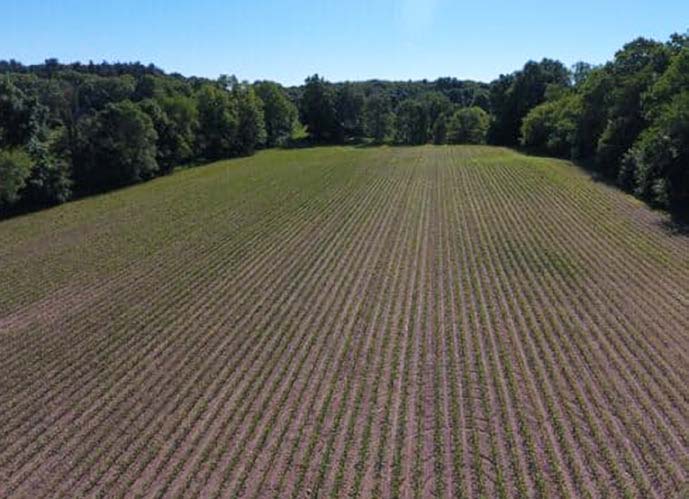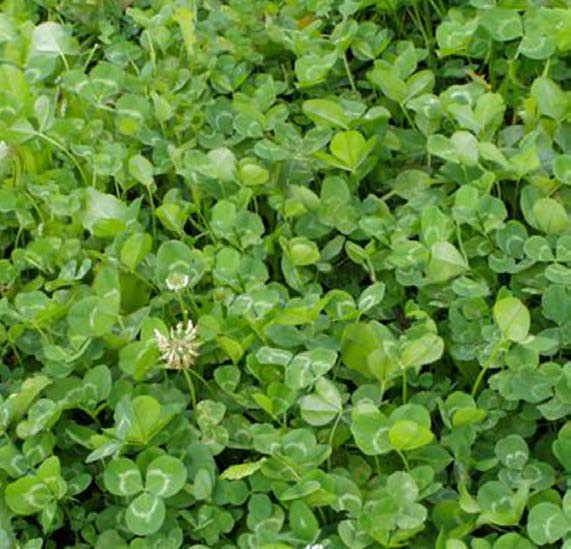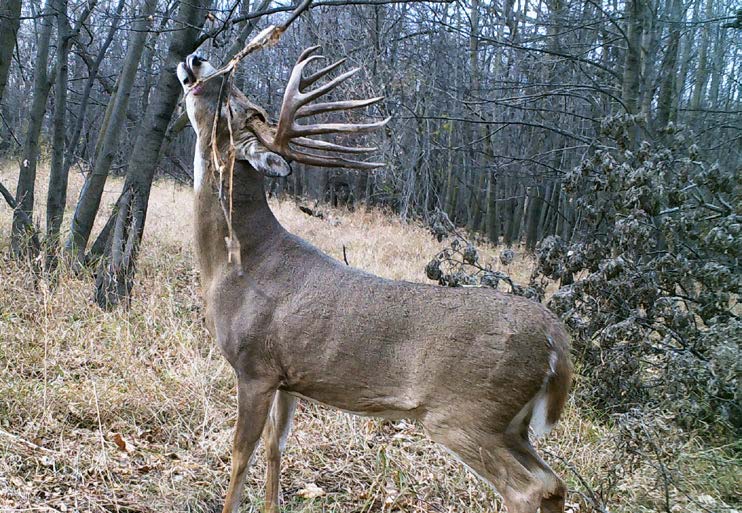A Playbook for Developing Your Whitetail Food Plot
In the Whitetail game, if you’re not planting food plots, you’re missing one of the key aspects contributing to good deer and turkey hunting on your property. Deer need quality food and will travel miles to find it. Simply stated, “if you plant it or build it, they will come.”
Planting food plots requires a little elbow grease, but a weekend or two of work will pay huge dividends this fall.
FOOD PLOT BASICS
In the simplest form, all you need to grow a good food plot is some dirt and some seed. But nothing is ever that simple because the dirt has to be suitable to support growth. That typically requires some work. But food plotting is not all that tough, as millions of hunters have discovered. Plus, it’s fun, and you’ll be glad you did it come the fall season. Following these five steps will generally get the job done.

Step 1: Test Your Soil
This is the most important step, but it is also the easiest— and unfortunately, the one rookies are likely to skip.
First, take soil samples by removing a number of pint-size scoops with a hand trowel or soil sample auger. Follow an “X” pattern across the plot and put all dirt in one pail. Stir and mix the soil, and then remove 1½ cups and place it in a polybag for analysis.
You want to obtain the average of a good cross-section of the plot. The soil can be analyzed by an agriculture extension service or private soil testing service. Most agriculture stores can help. Be sure to indicate what you intend to plant—clover, chicory, etc. With that information, the service will be able to recommend the amount of lime and the type of fertilizer to apply per acre.
If your soil is overly acidic, you will need to apply lime to neutralize the acid. This is absolutely necessary and is best done well before planting. Lime generally works slowly, so it may take multiple applications over a few years to “sweeten” your plot. That’s the bad news, but the good news is that it should stay sweet for a good, long time. Fertilizer will be added at planting time.
Step 2: Remove Competing Growth
After determining the soil’s pH, apply herbicides and/or cultivate to kill all weeds and grasses. We apply Roundup® or a glyphosate-based generic product first. Glyphosates do not work on dormant plants. For spring planting, we wait until most of the weeds and grasses have popped up before applying glyphosates to our plots.
Herbicides work best when applied vigorously to growing plants. Plowing and disking weeds without herbicide treatment is not as effective as applying herbicides first. You almost always see weed and grasses pop up, regardless of how thoroughly you plow and disk. Killing weeds with herbicides is more efficient than trying to eliminate them through cultivation. That’s why most commercial growers use them.
Step 3: Prepare the Soil
After the herbicide does its job, which takes about a week or so, it’s now time to work the soil with a plow, disk, rake, or some other tool to work dead matter into the soil and break up dirt clods for a smooth seedbed.
The goal here is to prepare a fine, relatively smooth surface to apply your seed. This is one of the toughest steps for food plotters who don’t have access to tools designed to work dirt into plantable conditions. Sandy, light soils generally work up easily, but some heavy clay- type soils can be tougher. Weather conditions have a lot to do with working soils. Wet soil generally isn’t easy, so try dry, sun-baked soils. Keep an eye on local farmers who have soils similar to yours. If they are working the ground, you probably should be as well.
You’ll know your soil is ready for planting if you can cast a handful of seeds and none (or very few) fall into deep crevices or are disappearing under or around foreign matter like dead weeds or heavy dirt clods. Essentially, you are looking for a planting surface that is as smooth and even as you can create without turning the surface into dirt. Once again, check out the local farmers who are seeding their fields. Your finished product should resemble theirs (provided they are not using no-till equipment).
Step 4: Fertilize
After breaking up dirt clods, add fertilizer if the soil tests call for it. Here is where your soil test is worth one thousand times the time and money you spent on it! If your soil has been tested and you indicated what you intend to plant, your results should include fertilizer recommendations. If you are super lucky, your soil may be able to support growth without adding any fertilizer. The only way to know for sure is to test your soil. You don’t want to find that out in the middle of the growing season when your plots run out of nutrition and fail.
Fertilizer can be spread by hand with lawn spreaders in small plots, but it is best done mechanically in most plots. Several companies offer spreaders that can be pulled with an ATV or tractor.

Step 5: Seed
Today’s food-plot blends specify how much seed to apply per acre. This information is found on the bag. Follow the manufacturer’s recommendations. It’s tempting to exceed the recommended level because if one bag is good, two must be better, right? Dead wrong! If you apply too much seed, the now-overcrowded plants produce less forage per acre.
On the other hand, don’t try to stretch your dollars too far. Sow too few seeds, and weeds will encroach between the plants. If you’re confident in your soil and its preparation, plant as recommended by the manufacturer. If you don’t expect good germination or if deer density is high, plant a bit more.
High-quality seed can be expensive, and your dollars will stretch further if you proceed carefully. If you don’t have an expensive metered seeder (and most people don’t), get a small, food-type scale to measure out a quarter-acre at a time. Then use an over-the-shoulder crank seeder (about $20) to spread it. They are very effective. Better to trickle your seed and go over the same quarter acre of ground a couple of times than to blow it out the first 20 yards. (Been there, done that.) Also, don’t pour too much seed into the hopper all at once, especially if you’re using a large-capacity seeder. Trust us, $100 of clover seed can disappear before you know it.
You might also want to consider using an ATV or tractor-driven seeder. A three-acre food plot is a lot of ground to seed by hand. ATV seeders are expensive, but a joy to use. The best are wheel-driven. Food plotters often hire local farmers to work their bigger food plots. These fellows have the equipment and know-how to get it done in a hurry. Unfortunately, most of them will be busy with their own planting just when you need them (at least in spring). Do not hand- cast the seed; this is wasteful and creates uneven stands.
After seeding, you can either walk away from the plot and let the rain (hopefully) create seed-to-ground contact or run some kind of roller or compactor/cultipacker over your seed. Do not bury seed deeply with a disc or other cultivation tool. Buried seed is dead seed!
Basically, your seed should be covered with no more dirt than three times the thickness of your seed. On tiny food plots, we sometimes “drive the seed in” by running an ATV over it to pack it with the tires. If you’re planting clover, rape, chicory, or other small seeds, it’s easy to bury them too deeply. If you cannot “contact” the seed to the soil by rolling, we believe it’s better to leave the job to Mother Nature.
Hoping for Rain
Ideally, gentle rain will arrive as soon as you finish seeding. Rain and soil moisture are critical to success. But you aren’t looking for three days of gully-washers that can wash away all your fertilizer and seed, either.
The worst scenario is germination followed by drought. Tiny seedlings need moisture to survive. Germination followed by drought is fatal to any kind of crop. Timing your seeding pays dividends. You can play the weather only a few days at a time, but it’s worth a try. Beyond that, it’s all up to Mother Nature. But remember, nothing happens without moisture and, of course, too much moisture is almost as bad as too little.
Thinking about all of this, it’s no wonder farmers are such patient people.
— NOW’S THE TIME TO CARE FOR FRUIT TREES —
Late winter is the perfect time to ensure you will have a hot spot to hunt Whitetails next fall. That means it’s time to take care of your fruit trees so they will return the favor come autumn.
If you spent a lot of time in the woods last fall, you probably came upon more than a few fruit trees in your hunting area. They pop up all over the place, thanks to wild critters and birds who spread seeds and drop fertilizer at the same time. Wild fruit trees often line fence rows and are commonly found where wooded areas meet open spaces. We refer to trees of this type as “volunteers.”
Unfortunately, most volunteers just show up, since Mother Nature planted them and forgot to give them plenty of space to grow. Volunteer fruit trees thrive for a while, but they eventually get overwhelmed by competing trees and shrubs. By the time you find them, they often are on the downside of their lifecycle because they grow tall and spindly in a desperate attempt to gather sunlight. Eventually, these trees quit producing and will topple over, or give up the ghost altogether.
Overcrowding and overstoring are the number- one enemies of fruit producers in the wild. A little TLC with a saw on a winter’s afternoon can breathe new life into these trees and create a Whitetail hotspot for years to come.
Releasing
Removing competing trees and shrubs from a 20- to 30-yard radius of the tree allows it to gather more moisture and nutrients from the ground and receive much-needed sunlight. When you do this, pay particular attention to clearing shade-producing trees from the east, west, and south sides of the tree. That’s the direction from which most of the sun will be coming. The tree you’re working on will benefit most if direct sunlight is available all day. This practice is commonly referred to as “releasing,” for obvious reasons.
Pruning
Your planted fruit trees, as well as your volunteers, will also benefit from a little selective branch removal or pruning this winter. Trimming out all dead and decaying branches will help keep diseases and harmful insects from infecting the rest of the tree.
Thinning crowded, touching branches will promote summer air circulation and permit sunlight to reach the ripening fruit. You’ll want to make a clean cut, not a cut that damages other branches. Don’t remove more than 25 to 30 percent of a tree’s living branches during thinning.
Spreading your thinning out over a few years is better than doing one heavy pruning, as well. Whatever you do, don’t put the job off until spring, when the sap is on the move and the buds are exploding. A good pruning job is like a good haircut: not a scalping, just a nice “clean up.”
If you own and know how to run a chainsaw, that’s the way to go. Be sure to wear protective leggings, a hard hat, and eye and ear protection. A hand-operated bow saw will get the job done, too, as will a pruning saw and lopping shears if you’re only dealing with small material. Axes are not only dangerous, but they also make sloppy, disease- inducing cuts. You can generally release and prune up a fruit tree or two in a winter’s afternoon, and the cuttings will be cleaned up (by the deer) in short order.
A well-maintained tree will produce fruit year after year and be used by dozens of wildlife species. Best of all, you now have another sure bet to set up on hungry Whitetails.
Per our affiliate disclosure, we may earn revenue from the products available on this page. To learn more about how we test gear, click here.







